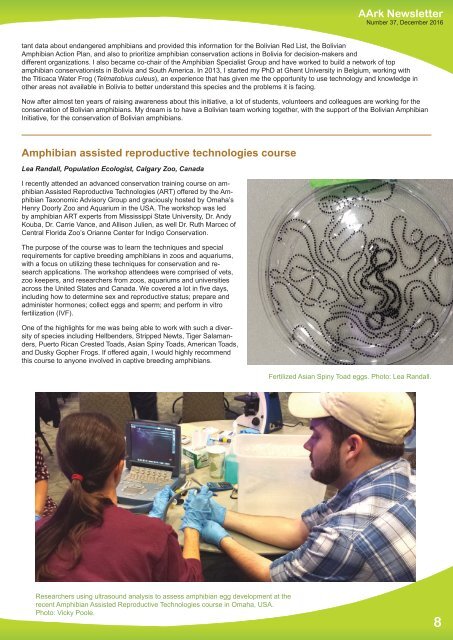amphibian ark
AArk-newsletter-37
AArk-newsletter-37
You also want an ePaper? Increase the reach of your titles
YUMPU automatically turns print PDFs into web optimized ePapers that Google loves.
AArk Newsletter<br />
Number 37, December 2016<br />
tant data about endangered <strong>amphibian</strong>s and provided this information for the Bolivian Red List, the Bolivian<br />
Amphibian Action Plan, and also to prioritize <strong>amphibian</strong> conservation actions in Bolivia for decision-makers and<br />
different organizations. I also became co-chair of the Amphibian Specialist Group and have worked to build a network of top<br />
<strong>amphibian</strong> conservationists in Bolivia and South America. In 2013, I started my PhD at Ghent University in Belgium, working with<br />
the Titicaca Water Frog (Telmatobius culeus), an experience that has given me the opportunity to use technology and knowledge in<br />
other areas not available in Bolivia to better understand this species and the problems it is facing.<br />
Now after almost ten years of raising awareness about this initiative, a lot of students, volunteers and colleagues are working for the<br />
conservation of Bolivian <strong>amphibian</strong>s. My dream is to have a Bolivian team working together, with the support of the Bolivian Amphibian<br />
Initiative, for the conservation of Bolivian <strong>amphibian</strong>s.<br />
Amphibian assisted reproductive technologies course<br />
Lea Randall, Population Ecologist, Calgary Zoo, Canada<br />
I recently attended an advanced conservation training course on <strong>amphibian</strong><br />
Assisted Reproductive Technologies (ART) offered by the Amphibian<br />
Taxonomic Advisory Group and graciously hosted by Omaha’s<br />
Henry Doorly Zoo and Aquarium in the USA. The workshop was led<br />
by <strong>amphibian</strong> ART experts from Mississippi State University, Dr. Andy<br />
Kouba, Dr. Carrie Vance, and Allison Julien, as well Dr. Ruth Marcec of<br />
Central Florida Zoo’s Orianne Center for Indigo Conservation.<br />
The purpose of the course was to learn the techniques and special<br />
requirements for captive breeding <strong>amphibian</strong>s in zoos and aquariums,<br />
with a focus on utilizing these techniques for conservation and research<br />
applications. The workshop attendees were comprised of vets,<br />
zoo keepers, and researchers from zoos, aquariums and universities<br />
across the United States and Canada. We covered a lot in five days,<br />
including how to determine sex and reproductive status; prepare and<br />
administer hormones; collect eggs and sperm; and perform in vitro<br />
fertilization (IVF).<br />
One of the highlights for me was being able to work with such a diversity<br />
of species including Hellbenders, Stripped Newts, Tiger Salamanders,<br />
Puerto Rican Crested Toads, Asian Spiny Toads, American Toads,<br />
and Dusky Gopher Frogs. If offered again, I would highly recommend<br />
this course to anyone involved in captive breeding <strong>amphibian</strong>s.<br />
Fertilized Asian Spiny Toad eggs. Photo: Lea Randall.<br />
Researchers using ultrasound analysis to assess <strong>amphibian</strong> egg development at the<br />
recent Amphibian Assisted Reproductive Technologies course in Omaha, USA.<br />
Photo: Vicky Poole.<br />
8


